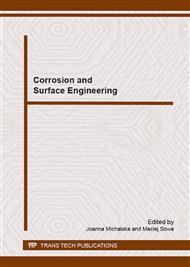p.425
p.431
p.435
p.439
p.443
p.447
p.451
p.455
p.459
Effect of Polarization Scan Rate on the Pitting Potential of the Self-Passivated NiTi Shape Memory Alloy in a Simulated Body Fluid
Abstract:
The pitting potential, Epit, of the passive layer on the implant alloy can be treated as an accelerated laboratory test to assessment a susceptibility to pitting corrosion of metallic biomaterials in simulated body fluids. This study deals with an evaluation of Epit of the self-passivated TiO2 layer formed on the surface of the NiTi implant alloy as a function of the scan rate of polarization. Cyclic potentiodynamic studies were performed in Ringer’s solution at 37°C. It was found out that the more noble value of Epit in the range of 0.99-2 V was registered at a given polarization scan rate that ranged from 0.16 to 2 mV s-1, the lower susceptibility of the self-passivated NiTi implant alloy to the initiation of pits was detected.
Info:
Periodical:
Pages:
443-446
Citation:
Online since:
January 2015
Authors:
Price:
Сopyright:
© 2015 Trans Tech Publications Ltd. All Rights Reserved
Share:
Citation:


